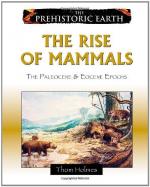|
This section contains 373 words (approx. 2 pages at 300 words per page) |
In geologic time, the Paleocene Epoch occurs during the Tertiary Period (also sometimes divided or referred to in terms of a Paleogene Period and a Neogene Period instead of a Tertiary Period) of the Cenozoic Era of the Phanerozoic Eon. The Paleocene Epoch is the earliest epoch in the Tertiary Period (in the alternative, the earliest epoch in the Paleogene Period).
The Paleocene Epoch spans the time between roughly 65 million years ago (mya) and 55 mya.
The Paleocene Epoch is further subdivided into (from earliest to most recent) Danian (65 mya to 61 mya) and Thanetian (61 mya to 55 mya) stages. The Eocene Epoch followed the Paleocene Epoch.
The onset of the Paleocene Epoch is marked by the K-T boundary or K-T event, a large mass extinction. Most scientists argue that the K-T extinction resulted from—or was initiated by—a large asteroid impact in a submerged area off the Yucatan Peninsula of Mexico termed the Chicxulub crater. The impact caused widespread primary damage due to blast impact and firestorms. Post-impact damage to Earth's ecosystem occurred as dust, soot, and debris from the collision occluded the atmosphere to sunlight. The global darkening was sufficient to slow photosynthesis and the resulting climatic changes and widespread starvation resulted in extinction of the largest life forms with the greatest metabolic energy needs (e.g., the dinosaurs).
Other impact craters that date within the Paleocene Epoch include sites in Alberta, Canada and Marquez, Texas.
The Paleocene Epoch marks the rise of mammals as the dominant land species. During the Paleocene Epoch, climatic moderations reduced the evolutionary pressure of extreme swings in climate. Although a diversity of mammals had evolved and widely populated the changing continental land-masses long before the Paleocene Epoch, the reduction in predator species allowed land mammals to dominate and thrive—eventually setting the stage from the evolution of homo sapiens (humans). Pine trees appeared during the Paleocene Epoch and avian species flourished and diversified.
See Also
Archean; Cambrian Period; Cretaceous Period; Dating Methods; Devonian Period; Evolution, Evidence Of; Fossil Record; Fossils and Fossilization; Historical Geology; Jurassic Period; Mesozoic Era; Miocene Epoch; Mississippian Period; Oligocene Epoch; Ordovician Period; Paleozoic Era; Pennsylvanian Period; Pleistocene Epoch; Pliocene Epoch; Precambrian; Proterozoic Era; Quaternary Period; Silurian Period; Supercontinents; Triassic Period
|
This section contains 373 words (approx. 2 pages at 300 words per page) |


